RBSE Solutions for Class 11 Chemistry Chapter 2 Structure of Atom
Rajasthan Board RBSE Solutions for Class 11 Chemistry Chapter 2 Structure of Atom Textbook Exercise Questions and Answers.
Rajasthan Board RBSE Solutions for Class 11 Chemistry in Hindi Medium & English Medium are part of RBSE Solutions for Class 11. Students can also read RBSE Class 11 Chemistry Important Questions for exam preparation. Students can also go through RBSE Class 11 Chemistry Notes to understand and remember the concepts easily.
RBSE Class 11 Chemistry Solutions Chapter 2 Structure of Atom
RBSE Class 11 Chemistry Structure of Atom InText Questions and Answers
Question 2.1.
Calculate the number of protons, neutrons and electrons in 38 Br.
Answer:
For 8035Br
Atomic number (Z) = 35
Mass number (A) = 80
No. of protons = No. of electrons
= Atomic number = Z = 35
Number of neutrons = Mass number (A) - Atomic number (Z)
= 80 - 35 = 45
Question 2.2.
The number of electrons, protons and neutrons in a species are equal to 18, 16 and 16 respectively. Assign the proper symbol to the species.
Answer:
Atomic number (Z) = Number of protons = 16
The element having atomic number 16 is sulphur (S). Mass number (A) = Number of protons + Number of neutron
= 16 + 16 = 32
∴ Number of electrons is not equal to number of protons, and difference is 18 - 16 = 2.
So, it is anion (negatively charged).
So, Proper symbol of the species is

Question 2.3.
The Vividh Bharti station of All India Radio (Delhi) broadcast on a frequency of 1.368 kHz. Calculate the wavelength electromagnetic radiations emitted by transmitter. Which part of electromagnetic spectrum does it belong?
Answer:
The frequency of radiation emitted,
v = 1368 kHz - 1.368 × 103 Hz
= 1.368 × 103 s-1
We know that λ = \(\frac{c}{v}\)
\(\lambda=\frac{3 \times 10^8 \mathrm{~ms}^{-1}}{1.368 \times 10^3 \mathrm{~s}^{-1}}\)
Thus radiation of wave length 2.193 × 105 m lies in the radiowave region of the electromagnetic spectrum.
Question 2.4.
The wavelength range of visible spectrum extends from violet (400 nm) to red (750 nm). Express the frequency of the radiation in (Hz).
Answer:
Wavelength of violet light = 400 nm
λ = 400 × 10-9 m
frequency = v = \(\frac{c}{\lambda}\)
where, c is the velocity of light
\(v=\frac{3 \times 10^8 \mathrm{~ms}^{-1}}{400 \times 10^{-9} \mathrm{~m}}\)
= 7.5 × 1014 Hz
Wavelength of red light, λ = 750 nm
= 750 × 10-9 m C
Frequency = \(v=\frac{c}{\lambda}=\frac{3.0 \times 10^8 \mathrm{~ms}^{-1}}{750 \times 10^{-9} \mathrm{~m}}\)
V = 4.0 × 1014 Hz
thus, range of visible spectrum in terms of frequency is from 40 × 1014 Hz to 7.5 × 1014 Hz .
Question 2.5.
Calculate (a) wave number and (b) frequency of yellow radiation having wavelength 5800 Ao.
Answer:
(a) λ = 5800 Å = 5800 × 10−8 cm
Wave number (U)
\(\frac{1}{\lambda}=\frac{1}{5800 \times 10^{-10} \mathrm{~m}}\)
= 1.724 × 104 cm
b) Calculation of frequency
\(v=\frac{c}{\lambda}\)
∴ where c is the velocity of light
\(v=\frac{3 \times 10^8 \mathrm{~m} \mathrm{~s}^{-1}}{5800 \times 10^{-10} \mathrm{~m}}\)
Hence, wave number
(v) = 1.724 × 104 cm
frequency (v) = 5.172 × 1014 s-1
Question 2.6.
Calculate energy of one mole of photons radiation whose frequency is 5 × 1014 Hz.
Answer:
v = 5 x 1014 Hz
h = 6.626 × 10-34 Js
∵Energy, E = hv
= 6.626 × 10-34 Js x 5 x 1014 S
= 3.313 × 10-19 J
Energy of one mole of photons
= (3.313 × 10-19 J) × (6.022 × 1023 mol-1)
= 199.5.1 kJ mol-1
Question 2.7.
A 100 watt bulb emits monochromatic ligh of wavelength 400 nm. Calculate the numbe of photons emitted per second by the bulb.
Answer:
Power of the bulb = 100 watt = 100 J s
λ = 400 nm = 400 × 10-9
C = 3× 108 m s-1
h = 6.626 × 10-34 Js
Energy of one photon,

= 4.969 × 10-19
Number of photons emitted

= 2.012 × 1020 s-1

Question 2.8.
When electromagnatic radiation of way length 300 nm strike a metal surface sodium, electrons are emitted with kinet energy 1.68 × 105 J mol-1. What is th minimum energy needed to remove a electron from sodium ? What is th maximum wavelength that will cause photoelectron to be emitted?
Answer:
Energy of striking photon
E = hv = \(\frac{h c}{\lambda}\)
\(=\frac{6 \cdot 626 \times 10^{34} \mathrm{~J} \mathrm{~s} \times 3 \cdot 0 \times 10^8 \mathrm{~m} \mathrm{~s}^{-1}}{300 \times 10^{-9} \mathrm{~m}}\)
= 6.626 × 10-19 J
Energy of 1 mole photon
= 6.626 × 10-19 J× 6.023 × 1023 mol
= 3.99 × 105 J mol-1
Minimum energy required to eject one mole electons from sodium
= (3.99 - 1.68) × 105 J mol-1
= 2.3 × 105 J mol-1
Maximum energy for one electron
\(=\frac{2 \cdot 31 \times 10^5 \mathrm{~J} \mathrm{~mol}^{-1}}{6 \cdot 023 \times 10^{23} \text { electron mol }^{-1}}\)
= 3.84 × 10-19 J
Wave length associated with this = λ
\(=\frac{h c}{E}=\frac{6 \cdot 626 \times 10^{-34} \mathrm{~J} \mathrm{~s} \times 3.0 \times 10^8 \mathrm{~m} \mathrm{~s}^{-1}}{3 \cdot 84 \times 84^{-19} \mathrm{~J}}\)
= 517 nm. (this is associated with green light) at
Question 2.9.
The thershold frequency of a metal is 7.0 × 1014 s-1. Calculate the kinetic energy of an electron emitted when radiation of frequency 1.0 × 1015 s-1 strikes this metal.
Answer:
Kinetic energy according to Einstein equation
1/2 mv2 = h(v - vo)
= 6.626 × 10-34 (1.0 × 1015 - 7.0 × 1014)
= 6.626 × 10-34 (10.0 × 1014 7.0 × 1014)
= (6.626 × 10-34 ) Js (3.0 × 1014 s−1)
= 1.988 × 10-19J
Question 2.10.
Calculate the frequency and wavelength associated with a photon emitted during the transition between n = 5 to n = 2 in hydrogen atom.
Answer:
As n1 = 5 and no 2
Hence, a spectrum line is obtained in Balmer series by this transition.
\(\Delta E=2 \cdot 18 \times 10^{-18}\left(\frac{1}{5^2}-\frac{1}{2^2}\right) \mathrm{J}\)
= -4.58 × 10-19 J
This is emitted energy.
Frequency of photon can be given by
\(v=\frac{\Delta E}{h}=\frac{\left(-4.58 \times 10^{-19} \mathrm{~J}\right)}{6.626 \times 10^{-34} \mathrm{~J} \mathrm{~s}}\)
= 6.91 x 1014 Hz
\(\lambda=\frac{c}{v}=\frac{3 \cdot 0 \times 10^8 \mathrm{~m} \mathrm{~s}^{-1}}{6 \cdot 19 \times 10^{14} \mathrm{~Hz}}\)
= 485 nm.
Question 2.11
Calculate the energy associated with first orbit of He. What is radius of this orbit?
Answer:
\(E_n=\frac{\left.(2 \cdot 18) \times 10^{-18} \mathrm{~J}\right) Z^2}{n^2} \mathrm{~J}^2 \text { atom }^{-1}\)
n = 1, Z = 2,
So,
\(E_n=\frac{-\left(2 \cdot 18 \times 10^{-18} \mathrm{~J}\right) \times(2)^2}{1^2}\)
= -8.72 × 10-18 J
For radius
\(r_n=\frac{(0.0519 \mathrm{~nm}) n^2}{Z}=\frac{(0.0529 \mathrm{~nm}) \times 1^2}{2}\)
= 0.02645 nm

Questionn 2.12
What will be the wavelength of a ball of mass 0.1kg moving with velocity 10 m/s?
Answer:
According to de-Broglie equation
\(\begin{aligned} \lambda & =\frac{h}{m v} \\ & =\frac{6 \cdot 626 \times 10^{-34} \mathrm{Js}}{0 \cdot 1 \mathrm{~kg} \times 10 \mathrm{~m} \mathrm{~s}^{-1}} \end{aligned}\)
= 6.626 × 10-34 m
(J = kgm 2s-2)
Question 2.13.
The mass of an electron is 9. 1× 10 -31 kg. If its kinetic energy is 3.0 × 10-25 J, calculate its wavelength.
Answer:
Kinetic energy = 1/2 mv2
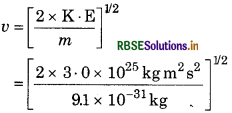
= 812 m s-1
\(\lambda=\frac{6 \cdot 626 \times 10^{-34} \mathrm{~J} \mathrm{~s}}{9 \cdot 1 \times 10^{-31} \mathrm{~kg} \times 812 \mathrm{~m} \mathrm{~s}^{-1}}\)
= 8967 × 10-10 m
= 897.6 nm
Question 2.14.
Calculate the mass of photon of light having wavelength 3.6Å.
Answer:
λ = 3.6Å = 3.6 × 10-10 m
Velocity of photon = Velocity of light

= 6.135 × 10-29 kg
Question 2.15.
An microscope using suitable photons is employed to locate an electron with in a distance of 0.1 Å. What is the uncertainty involved in the measurment of its velocity [mass m = 9.11 × 10-31 kg]
Answer:
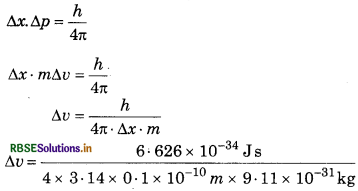
= 0.579 × 107 m s -1
= 5.79 × 106 ms-1
Question 2.16.
A golf ball has a mass of 40 g and a speed of 45 m/s. If the speed can be measured with accuray of 2%, calculate the uncertainty in position.
Answer:
Ucertainty in speed 2%, it means
Δυ = 45 x 2/100 = 0.9 m/s
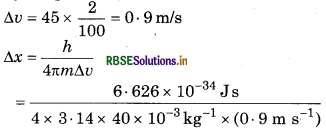
= 1.46 × 10-33m.
Question 2.17.
What is the total number of orbitals associated with the principal quantum number n = 3?
Answer:
Maximum number of orbitals in a shell
= n2 = (3)2 = 9

Question 2.18.
Using s,p,d,f notations, describe the orbital with the following quantum numbers:
(a) n = 2, 1 = 1
(b) n = 4, l = 0
(c) n = 5, l = 3
(d) n = 3, l = 2
Answer:
(a) n = =2, 1=1
(b) n = 4, 1= 0
(c) n = 5, l = 3
(d) n = 3, l = 2
RBSE Class 11 Chemistry Structure of Atom Textbook Questions and Answers
Question 2.1.
(i) Calculate the number of electrons which will together weigh one gram.
(ii) Calculate the mass and charge of one mole of electrons.
Answer:
(i) Mass of electron = 9.1 × 10-31 kg
= 9.1 × 10-28 g
∵ 9.1 × 10-28 g is the mass of 1 elelctron
∴ 1.0 g will be the mass of = \(\frac{1}{9.1 \times 10^{-28}}\) elelctron
= 1.098 × 1027 electron
(ii) Mass of electron = 9.1 × 10-31 kg
∴ Mass of one mole of electron
= (9.1 × 10) kg) × (6.022 × 1023 mol-1)
= 5.486 × 10-7 kg/mol
Charge on one electron = 1.602 × 10-19 coulomb
∴ Charge on one mole of electron
= (1.602 × 10-19 coulomb) × (6.022 × 1023 mol)
= 9.65 x 104 coulomb/mol
Question 2.2.
(i) Calculate the total number of electr present in one mole of methane.
(ii) Find (a) the total number and (b) the to mass of neutrons in 7 mg of 14 C. (Assume that mass of a neutron = 1675 × 10-27 kg).
(iii) Find (a) the total number and (b) the to mass of protons in 34 mg of NH3 at STP. V the answer change if the temperature a pressure are changed?
Answer:
(i) 1 molecule of CH4 contains = 6 + 4= 10 electrons
∴1 mole i.e., 6.022 × 10
molecules will contain
= 6.022 × 1023 × 10
= 6.022 × 1024 electrons/mol
(a) 1 g atom of 14 C = 14g = 6.022 × 1023 atoms
= 6.022 × 1023 x 8 neutrons
(as each Catom has 14 - 6 = 8 neutrons)
Thus 14g on 14000 mg have 8 × 6.022 × 1023 neutro
∴ 7 mg will have neutrons
= \(\frac{8.6 .022 \times 10^{23}}{14000} \times 7\)
= 2.4088 x 1021
(b) Mass of 1 neutron = 1.675 × 10-27 kg
∴Mass of 2.4088 × 10-21 neutrons
= (2.4088 × 1021) (1.675 × 10-27 Kg)
= 4.0347 × 10-6 Kg
(iii) (a) 1 mol of NH3 = 17 g NH3 kg
= 6.022 × 1023 molecules of NH3
= 6.022 × 1023 × (7 + 3) protons
= 6.022 × 1024 protons
∴34 mg i.e., 0.034 g NH3
= \(\frac{6.022 \times 10^{24}}{17}\)
= 12044 × 1022 protons
(b) Mass of 1 proton = 1.6726 × 10-27 Kg
∴ Mass of 1.2044 × 10 protons
= (1.6726 × 10-27) × (12.44 × 1022 kg)
= 2.0145 × 10 kg
If the temperature and pressure are changed then answer will not be changed because only the number of protons and mass of protons are involved.

Question 2.3.
How many neutrons and protons are there in the following nuclei?
5618 C, 16O, 22Mg, 26 Fe, 88Sr
Answer:
|
Nuclei |
Number of protons |
Number of Neutrons (Mass number – Atomic number) |
|
136C |
6 |
13 - 6 = 7 |
|
168O |
8 |
16 – 8 = 8 |
|
2412Mg |
12 |
24 -12 = 12 |
|
5626Fe |
26 |
56 – 26 = 30 |
|
8838Sr |
38 |
88 – 38 = 50 |
Question 2.4.
Write the complete symbol for the atom with the given atomic number (Z) and atomic mass (A).
(i) Z = 17, A = 35.
(ii) Z = 92, A = 233.
(iii) Z = 4, A = 9.
Answer:
|
Atomic number (Z) |
Atomic mass |
Symbol of Atom |
|
17 |
35 |
3517Cl |
|
92 |
233 |
23392U |
|
4 |
9 |
94Be |
Question 2.5.
Yellow light emitted from a sodium lamp has a wavelength (2) of 580 nm. Calculate the frequency (v) and wave number (v) of the yellow light.
Answer:
Wavelength (2) = 580nm = 580 × 10-9 m
Frequency (v) \(=\frac{\mathrm{c}}{\lambda}\)
\(=\frac{3 \times 10^8 \mathrm{~m} \mathrm{~s}^{-1}}{580 \times 10^{-9} \mathrm{~m}}\)
= 5.17 × 104 s-1
Wave number (v)
= \(\frac{1}{\lambda}=\frac{1}{580 \times 10^{-9} \mathrm{~m}}\)
= 1.724 x 106 m-1
= 1.724 x 104 cm-1
Question 2.6.
Find the energy of each of the photons which
(i) correspond to light of frequency 3 × 1015 Hz.
(ii) have wavelength of 0.50 Å.
Answer:
(i) v = 3 x 1015 Hz
E = hv
= 6.626 × 10 J s× 3 × 1015 s-1
= 1.988 × 10-18J
(ii) λ = 0.50Å = 0.50 × 10-10 m

= 3.98 × 10-15J

Question 2.7.
Calculate the wavelength, frequency and wave number of a light wave whose period is 2.0 × 10-10 s.
Answer:
Time period = 2.0 × 10-10
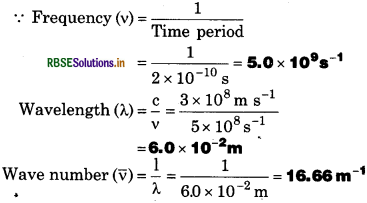
Question 2.8.
What is the number of photons of light with a wavelength of 4000 pm that provide 1J of energy?
Answer:
Wavelength (2) = 4000 pm
= 4000 × 10-12 m
= 4 × 10-9 m
E = Nhv = Nh C/λ

= 2012 × 1016 protons.
Question 2.9.
A photon of wavelength 4 × 10-7 m strikes on metal surface, the work function of the metal being 2.13 eV. Calculate (i) the energy of the photon (eV), (ii) the kinetic energy of the emission, and (iii) the velocity of the photoelectron (1 eV = 16020 × 10-19 J).
Answer:
Wavelength of photon (2) = 4 × 10−7 m
Work function = 2.13 eV
(i) Energy of the photon \(E=\frac{h c}{\lambda}\)
\(=\frac{6.626 \times 10^{-34} \mathrm{~J} \mathrm{~s} \times 3.0 \times 10^8 \mathrm{~m} \mathrm{~s}^{-1}}{4 \times 10^{-7} \mathrm{~m}}\)
= 4.97 × 10-19J
∵ 1 eV = 1.602 × 10-19 J
or \(1 \mathrm{~J}=\frac{1}{1.602 \times 10^{-19}} \mathrm{eV}\)
∴ \(E=\frac{4.97 \times 10^{-19}}{1.602 \times 10^{-19}}\)
= 3.10 eV
(ii) Kinetic energy of the emission= Energy of the photon - Work function
= 3.1 - 2.13 = 0.97 eV
(iii) Velocity of photoelectron
K.E. = 1/2 mv2
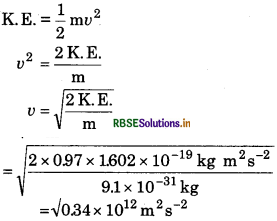
= 0.583 × 106 ms-1
= 5.83 × 103ms-1

Question 2.10.
Electromagnetic radiation of wavelength 242 nm is just sufficient to ionise the sodium atom. Calculate the ionisation energy of sodium in kJ mol-1.
Answer:
E = N hv = \(N h \frac{C}{\lambda}\)
\(=\frac{\begin{array}{c} \left(6.022 \times 10^{23} \mathrm{~mol}^{-1}\right) \times\left(6.626 \times 10^{-34} \mathrm{Js}\right) \\ \times\left(3 \times 10^8 \mathrm{~ms}^{-1}\right) \end{array}}{242 \times 10^{-9} \mathrm{~m}}\)
= 4.945 × 105 J mol-1
= 494.5 kJ mol-1
Question 2.11.
A 25 watt bulb emits monochromatic yellow light of wavelength of 0.57 μm. Calculate the rate of emission of quanta per second.
Answer:
Power of bulb (P) = 25 watt = 25 Js
Wavelength (2)= 0.57 μm = 0.57 × 10-6 m
Energy of photon \(E=\frac{h c}{\lambda}\)
\(=\frac{6.626 \times 10^{-34} \mathrm{~J} \mathrm{~s} \times 3.0 \times 10^8 \mathrm{~m} \mathrm{~s}^{-1}}{0.57 \times 10^{-6} \mathrm{~m}}\)
= 3.48 × 10-19 J
Rate of emission of quanta per second
\(=\frac{25 \mathrm{~J} \mathrm{~s}^{-1}}{3.48 \times 10^{-19} \mathrm{~J}}\)
= 7.18 × 1019 s−1
Question 2.12.
Electrons are emitted with zero veloc from a metal surface when it is exposed radiation of wavelength 6800Å. Calcul threshold frequency (vo) and W function (W) of the metal.
Answer:
Wavelength of radiation (λ) = 6800Å
= 6800× 10-10
= 6.8× 10-7 m
Frequency (v) = \(\frac{\mathrm{c}}{\lambda}\)
= \(\frac{3.0 \times 10^8 \mathrm{~m} \mathrm{~s}^{-1}}{6.8 \times 10^{-7} \mathrm{~m}}\)
= 4.41 x 1014 S-1
K.E. = 1/2m ev2 = h(v − vo)
or
1/2me x 0 = h(4.41 × 1014 - vo)
or
0 = h (4.41 × 1014 - vo)
∴ Thresehold frequency vo = 4.41 x 1014 s1
Work function (W0) = hvo
= 6.626 × 10-34J 4.41 × 1014 s-1
= 2.92 × 10-19 J
Question 2.13.
What is the wavelength of light emit when the electron in a hydrogen at undergoes transition from an energy le with n = 4 to an energy level with n = 2? n1 = 2 4
Answer:
n1 = 2
n2 = 4
∵ Wave number (v)
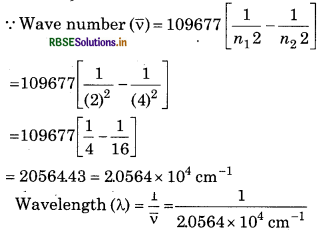
= 20564.43
= 2.0564 x 104 cm-1
Wavelength (λ)
= 0.486 × 10-4 cm
= 0.486 × 10-6 m
= 486 × 10-9 m = 486 nm

Question 2.14.
How much energy is required to ionise a atom if electron occupies n = 5 orb Compare your answer with the ionisati enthalpy of H atom (energy required remove the electron from n = 1 orbit).
Answer:
Energy for electron of H-atom present in a particular energy shell
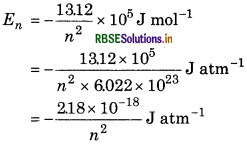
I.E for electron of H-atom present in 5th orbit, n = 5
IE5 = E - E5
\(=0-\left(\frac{-2.18 \times 10^{-18}}{25}\right) \mathrm{J} \mathrm{atm}^{-1}\)
= 8.72 × 10-20 J atm-1
I.E for electron of H-atom persent in 1st orbit, n = 1
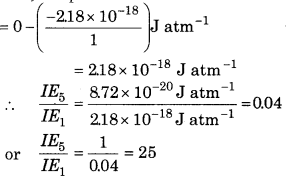
∴ IE1 is 25 times as compared to IE5.
Question 2.15.
What is the maximum number of emission lines when the excited electron of a H atom in n = 6 drops to the ground state?
Answer:
n = 6
Maximum number of emission lines
\(=\frac{6(6-1)}{2}=\frac{30}{2}=15\)
= 15
The actual transitions taking place are
(i) n = 6 to n = 1
6 → 5, 6 → 4, 6 → 3, 6 → 2, 6 → 1 (5 lines)
(ii) n = 5.to n = 1
5 →4, 53, 5 → 2, 5 → 1 (4 lines)
(iii) n = 4 to n = 1
4 → 3, 4 → 2, 4 → 1 (3 lines)
(iv) n = 3 to n = 1,
3 → 2, 3 → 1 (2 lines)
(v) n = 2 to n = 1,
2 →1 (1 lines)
Question 2.16
(i) The energy associated with the first orbit in the hydrogen atom is -2.18× 10-18 J atom-1. What is the energy associated with the fifth orbit?
(ii) Calculate the radius of Bohr's fifth orbit for hydrogen atom.
Answer:
(i) Energy assoiated with 1st orbit in H-atom
= -2.18× 10-18 J atm
n = 1
n2 = 5
For an electron,
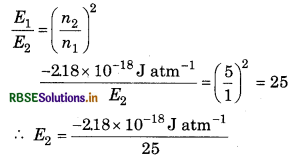
= -8.72 × 10-20 J
(ii) For H-atom, rn = 0.529 × n2 Å
rn = 0.529 × 52
Å = 13.225 Å
= 1.3225 nm

Question 2.17.
Calculate the wave number for the longest wavelength transition in the Balmer series of atomic hydrogen.
Answer:
Fro Balmer series, n1 = 2 and n2 = 3
Wave number
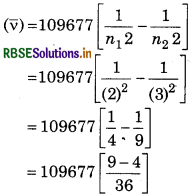
= 15233 cm-1
= 1.5233 × 104 cm-1
= 1.5233 × 106 m-1
Question 2.18.
What is the energy in joules, required to shift the electron of the hydrogen atom from the first Bohr orbit to the fifth Bohr orbit, and what is the wavelength of the light emitted when the electron returns to the ground state? The ground state electron energy is -2.18 × 10-11 ergs.
Answer:
Ground state electronic energy = -2.18× 10-11,
E1 = -218× 10-18 J
(1 J = 107ergs)
En = Energy in the nth orbit
Where n = number of the orbit
If n = 5
\(=\frac{-2.18 \times 10^{-18}}{n^2}\)
= -8.72 × 10-20J
∴ Energy has to be absorbed to promote electron from Bohrs first orbit to fifth orbit.
∆E = E5 - E1
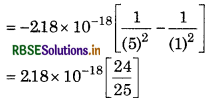
= 2.08 × 10-18 J
= 2.08 × 10-11 ergs
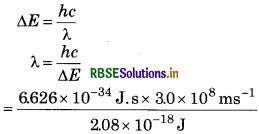
= 9.56× 10-8 m
= 956 × 10-10 m
= 956Å
Question 2.19.
The electron energy in hydrogen atom is given by E = (-218× 10-18 ) /n2 J. Calculate the energy required to remove an electron completely from the n = 2 orbit. What is the longest wavelength of light in cm that can be used to cause this transition?
Answer:
n = 2
Energy required (ΔE) = E∞ - En
= E∞ - E2
\(=0-\left(-\frac{2.18 \times 10^{-18} \mathrm{~J} \mathrm{atom}^{-1}}{(2)^2}\right)\)
= 5.45 × 10-19J atom-1
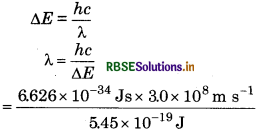
= 3.647 × 10-7 m
= 3.647 x 10-5cm

Question 2.20.
Calculate the wavelength of an electron moving with a velocity of 205 × 107 m s-1.
Answer:
Velocity of electon (v) = 2.05 × 107 m s
Mass of electron (m) = 9.1 × 10-31 kg
h = 6.626 × 10-34 kg m2s
According to de-Broglie equation,

= 3.55 × 10-11m
Question 2.21.
The mass of an electron is 9.1× 10-31 kg. its K.E. is 3.0 × 10 -25 J, calculate its wavelength.
Answer:
Mass of electron (m) = 9.1 × 10-31 kg
Kinetic energy (K.E.) of electron = 3.0 × 10-25 J
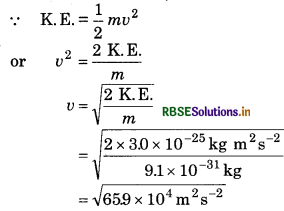
= 8.12 × 102 ms -1
According to de-Broglie equation,
\(\begin{aligned} \lambda & =\frac{h}{m v} \\ & =\frac{6.626 \times 10^{-34} \mathrm{~kg} \times \mathrm{m}^2 \mathrm{~s}^{-1}}{9.1 \times 10^{-31} \mathrm{~kg} \times 8.12 \times 10^2 \mathrm{~m} \mathrm{~s}^{-1}} \end{aligned}\)
= 0.08967 × 10-5 m
= 8967 × 10-10 m
= 8967Å
Question 2.22.
Which of the following are isoelectronic species i.e., those having the same numbe of electrons? Na+, K+, Mg2+, Ca2+, S2-, Ar
Answer:
Na+ Number of electrons = 11 - 1 = 10
K+ Number of electrons = 19 - 1 = 18
Mg2+ Number of electrons = 12 - 2 = 10
Ca2+ Number of electrons = 20 - 2 = 18
S2-,Number of electrons = 16 + 2 = 18
Ar Number of electrons = 18
Since Na+ and Mg2+ contain 10 electrons, so these ar isoelectronic species.
Similarly, K+, Ca 2+, S2- and Ar contain 18 electrons, s these are isoelectronic species.
Question 2.23.
(i) Write the electronic configurations of th following ions: (a) H- (b) Na+, (c)O2- (d) F-
(ii) What are the atomic numbers of element whose outermost electrons are represented b (a) 3s1, (b) 2p3 and (c) 3p5?
(iii) Which atoms are indicated by the followin configurations?
(a) [He]2s1, (b) [Ne] 3s2 3p3, (c) [Ar]4s2 3d1.
Answer:
(i) (a) No. of electrons in H+ = 1 - 1 = 0
Electronic configuration = 1s0
(b) No. of electrons in Na+ = 11 - 1 = 10
Electronic configuration = 1s2, 2s2 2p6
(c) No. of electrons in O2 = 8 + 2 = 10
Electronic configuration = 1s2,2s22p6
(d) No. of electrons in F = 9 + 1 = 10
Electronic configuration =1s2,2s22p6
(ii)
|
Outer most electronic configuration |
electronic configuration |
Atomic number |
|
3s1 |
1s2 2s2 2p6 3s1 |
11 |
|
2p3 |
1s2 2s2 2p3 |
7 |
|
3p5 |
1s2 2s2 2p6 3s2 3p5 |
17 |
Question 2.24.
What is the lowest value of n that allows g orbitals to exist?
Answer:
If value of 1 = 4, then g- orbitals can exist.
∵ l = n - 1
n = 1 + 1 = 4 + 1 = 5
Therefore, the lowest value of 'n' that allows g-orbitals to exist is 5.

Question 2.25.
An electron is in one of the 3d orbitals. Give the possible values of N l and ml for this electron.
Answer:
For 3d,
n = 3
l = 2
m1 = -2, -1, 0, +1, + 2
Question 2.26.
An atom of an element contains 29 electrons and 35 neutrons. Deduce (i) the number of protons and (ii) the electonic configuration of the element.
Answer:
Number of electrons = 29
Number of neutrons = 35
(i) Number of protons
= Number of electrons in neutral atom = 29
(ii) Electronic configuration=2, 8, 18, 1
= 1s2, 2s2 2p6, 3s2 3p6 3d1o, 4s1
Question 2.27.
Give the number of electrons in the species H2+, H2 and O2.
Answer:
Number of electrons in H2 = 2 − 1 = 1
Number of electrons in H2 = 2
Number of electrons in O2 = 16 - 1 = 15
Question 2.28.
(i) An atomic orbital has n = 3. What are the possible values of l and ml?
(ii) List the quantum numbner (m, and l) of electrons for 3d orbital.
(iii) Which of the following orbitals are possible? 1p, 2s, 2p and 3f
Answer:
(i) n = 3
l = 0 1 2
m1 = 0
-1, 0, +1
-2, -1, 0, + 1 +2
(ii) For 3d orbital
n = 3
1 = 2
m1 = -2, -1, 0, +1, + 2
(iii) 2s and 2p orbitals are possible.

Question 2.29.
Using s, p, d notations, describe the orbital with the follwoing quantum numbers:
(a) n = 1, 1 = 0;
(b) n = 3, l = 1,
(c) n = 4, l = 2;
(d) n = 4,1 = 3.
Answer:
(a) n = 1,7 = 0, Orbital is 1s.
(b) n = 3,1 = 1, Orbital is 3p.
(c) n = 4,1 = 2, Orbital is 4d.
(d) n = 4,7 = 3, Orbital is df.
Question 2.30.
Explain, giving reasons, which of the following sets of quantum numbers are not possible.
|
n = 0 |
l = 0 |
m1 = 0 |
ms = +1/2 |
|
n = 1 |
l = 1 |
m1 = 0 |
ms = −1/2 |
|
n = 2 |
l = 2 |
m1 = 0 |
ms = +1/2 |
|
n = 3 |
l = 3 |
m1 = 0 |
ms = −1/2 |
Answer:
(a) n = 0, 1 = 0, m1 = 0, ms = +1/2
"Not- possible"
Reason The value of n is never zero.
(b) n = 1, l = 0, m1 = 0, ms = −1/2
"Possible"
(c) n = 1, l = 1, m1 = 0, m ̧= +- 1/2
"Not-possible"
Reason: If n = 1, then / connot be equal to 1.
(d) n = 2, l = 1, m1 = 0, m ̧ = -1/2
Possible"
(e) n = 3, l = 3, m1 = 3, m ̧ = + 1/2
"Not possible"
Reason: If n = 3, then I cannot be equal to 3.
(f) n = 3, l = 1, m1 = 0, m ̧ = + 1/2
"Possible"

Question 2.31.
How many electrons in an atom may have the following quantum numbers:
(a) n = 4, ms = -1/2 (b) n = 3, 1 = 0.
Answer:
n = 4, m = -1/2
For n = 4;
Total number of electrons = 2n2 = 2(4)2 = 32
Half of these electrons will have m ̧ = -1/2
∴ Total electrons with m, (-1/2) = 16
(ii) For n = 3,l = 0
1 = 0,m1 = 0,ms = +1/2, 1/2
So, there are two electrons for this set of quantum number.
Question 2.32.
Show that the circumference of the Bohr orbit for the hydrogen atom is an integral multiple of the de-Brglie wavelength associated with the electron revolving around the orbit.
Answer:
According to Bohr's theory,
\(\begin{array}{r} m v r=\frac{n h}{2 \pi} \\ m v=\frac{n h}{2 \pi r} \end{array}\) ...... (1)
Now, according to de-Broglie equation,
\(\begin{aligned} \lambda & =\frac{h}{m v} \\ m v & =\frac{h}{\lambda} \end{aligned}\) ........ (2)
From equation (1) and (2)
\(\frac{n h}{2 \pi r}=\frac{h}{\lambda}\)
2πr = ηλ ........ (3)
C = nλ ......... (4)
[∵ С = 2πr]
Where C = Circumference
The equetion (4) shows thet the circumference of the Bohr's orbit for the H-atom is an integral multiple of the de-Broglie wavelength (nλ).
Question 2.33.
What transition in the hydrogen spectrum would have the same wavelength as the Balmer transition n = 4 to n = 2 of He+ spectrum?
Answer:
For He+ spectrum,
Z = 2
n1 = 2
n2 = 4
∵ Wave number (v)
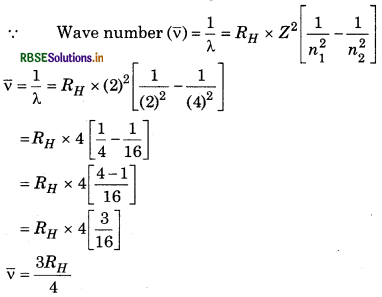
For hydrogen spectrum
Z = 1
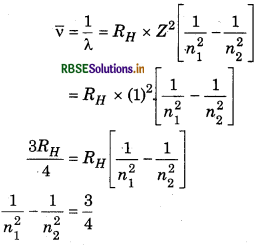
This represents n1 = 1 and n2 = 2 and it means that the transition shows Lyman series from n = 2 to n = 1. Therefore, transition takes plece from no to n1 in case hydrogen spectrum.
Question 2.34.
Cálculate the energy required for the process.
He2+ (g) → He2+ (g) + e-
The ionization energy for the H atom in the ground state is 218 × 10-18 J atom-1.
Answer:
For H-atom, Z = 1, n = 1
Ionization energy of the atom
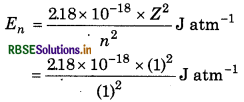
= 218 × 10-18 Jatm-1
=8.72 × 10-18 J atm-1

Question 2.35.
If the diameter of a carbon atom is 0.15 nm, calculate the number of carbon atoms which can be placed side by side in a straight line across length of scale of length 20 cm long.
Answer:
Diameter of C-atom = 0.15 nm,
Length of scale = 20 cm = 20 × 107 nm = 2× 108 nm
∴ No. of C-atom which can be placed side by side in the scale
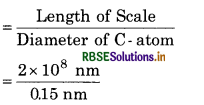
= 1.33 × 109 atoms
Question 2.36.
2 × 108 atoms of carbon are arranged side by side. Calculate the radius of carbon atom if the length of this arrangement is 2.4 cm.
Answer:
No. of C-atoms = 2 × 108
Length of the arrangement = 2.4 cm
∴ Diameter of each C-atom
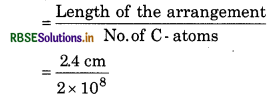
= 1.2 × 10-8 cm
Radius of C-atom

= 6.0 × 10-9 cm
Question 2.37
The diameter of zinc atom is 2.6 Å. Calculate (a) radius of zinc atom in pm and (b) number of atoms present in a length of 1.6 cm if the zinc atoms are arranged side by side lengthwise.
Answer:
Diameter of Zn atom = 2.6Å
(i) Radius of Zn atom

= 1.3 × 10-10m
= 130 × 10-12 m
= 130 pm
(ii) Length of scale = 1.6 cm = 1.6 × 10-2 m
= 1.6 x 10-2 × 1012 pm
= 1.6 × 1010 pm
Diameter of Zn atom = 2.6Å
= 26 × 10-10 m
= 260× 10-12 m
= 260 pm
∴ No. of Zn atoms pleaced side by side
\(=\frac{1.6 \times 10^{10} \mathrm{pm}}{260 \mathrm{pm}}\)
= 6.154 × 107
Question 2.38.
A certain particle carries 2.5 × 10-16 C of static electric change. Calculate the number of electrons present in it.
Answer:
Electric charge (q) = 2.5 × 10-16 C
∵ Charge on one electron (e) = 1.602 × 107 C
∴ Number of electrons present in particle
\(=\frac{2.5 \times 10^{-16} \mathrm{C}}{1.602 \times 10^{-19} \mathrm{C}}\)
= 1560

Question 2.39.
In Millikan's experiment, static electric charge on the oil drops has been obtained by shining X-rays. If the static electric charge on the oil drop is -1282 × 10-18 C. Calculate the number of electrons present in it.
Answer:
Static electric charge on oil drop
(q) = -1.282 × 10-18 C
Charge or an electron
(e) = -1.602 × 10-19 C
∴ No. of electrons present on oil drop
\(=\frac{q}{e}=\frac{-1.282 \times 10^{-18} \mathrm{C}}{-1.602 \times 10^{-19} \mathrm{C}}\)
Question 2.40.
In Rutherford's experiment, generally the thin foil of heavy atoms like gold, platinum etc. have been used to be bombarded by the a-particles. If the thin foil of light atoms like aluminium etc. is used, what difference would be observed from the above results?
Answer:
If the thin foil of light atoms like aluminium is used in Rutherford's experiment then more number of o -particles will pass from the foil. Moreover, smaller number of a-particles will be deflected as the number of positive charge is less on the lighter nuclei.
Question 2.41.
Symbols 7935Br and 79 Br can be written, whereas symbols Br and Br are not acceptable. Answer briefly.
Answer:
3579 Br is not acceptable because atomic number should be written as subscript and mass number should be written as superscript. 35 Br is not acceptable because atomic number of an element is fixed. However, mass number is not fixed as it depened upon the isotope taken.
Question 2.42.
An element with mass number 81.contains 317% more neutrons as compared to protons. Assign the atomic symbol.
Answer:
Mass number of element = 81
Let the number of protons in element = x
∴ Number of neutron = x + \(\frac{x \times 31.7}{100}\)
= x + 0.317x
∴ Mass number = Number of protons + Number of neutrons
81 = x + x + 0.317x
81 = 2.317x
or
\(x=\frac{81}{2.317}\)
= 35
∴ Number of protons
Now, number of neutrons - Mass number - No. of protons
= 81 - 35 = 46
Atomic number = No of protons
Hence, symbol of element
Question 2.43.
An ion with mass number 37 possesses one unit of negative charge. If the ion conatins 11.1% more neutrons than the electrons, find the symbol of the ion.
Answer:
Mass number of ion = 37
Charge of ion = -1
Suppose, number of electrons in an ion = x
∴ No of neutrons (n) = x + \(\frac{11.1 x}{100}\)
= x + 0.111x = 1.111x
In neutral atm, no. of electrons = x - 1
Similarly no. of protons (p) = x - 1
∵ Mass number = no. of neutrons + no. of protons
37 = 1.111x + x - 1
2.111x = 37 + 1 = 38
\(x=\frac{38}{2.111}\)
Number of protons = x - 1 = 18 - 1 = 17

Question 2.44.
An ion with mass number 56 contains 3 units of positive charge and 30.4% more neutrons than symbol to this ion. electrons. Assign the
Answer:
Mass number of ion 56
Charge on ion = +3
Suppose, number of electrons = x
Number of protons = x +3
Number of neutrons = x +
= x + 0.304x
= 1.304x
Mass number = No of protons + No. of nentrons
56 = x + 3 + 1.304x
2.304x = 56 - 6 = 53
\(x=\frac{53}{2.304}\)
∴ Number of electrons = 23
Number of portons = 23 + 3 = 26
Atomic number = No. of protons = 26
∴ Symbol of ion = 56 26 Fe3+
Question 2.45.
Arrange the following type of radiations in increasing order of frequency: (a) radiation from microwave oven, (b) amber light from traffic signal, (c) radiation from FM radio, (d) cosmic rays from outer space and (e) X- rays.
Answer:
Increasing order of frequency of radiation-Radiation from FM radio < Radiation from microwave oven < amber light from traffic signal < X-rays < Cosmic rays from outer space.
Question 2.46.
Nitrogen laser produces a radiation at a wavelength of 337.1 nm. If the number of photons emitted is 5.6 × 1024, calculate the power of this laser.
Answer:
Wavelength of radiation (λ) = 337.1 nm
= 337.1 × 10 m
No. of photons emitted (N) = 5.6 × 1024
h = 6.626 × 10-34 Js
c = 3 x 108 m s-1
Power of laser (E)
\(=\frac{5.6 \times 10^{24} \times 6.626 \times 10^{-34} \mathrm{Js} \times 3 \times 10^8 \mathrm{~m} \mathrm{~s}^{-1}}{337.1 \times 10^{-9} \mathrm{~m}}\)
= 3.3 × 106J
Question 2.47.
Neon gas is generally used in the sign boards. If it emits strongly at 616 nm. calculate (a) the frequency of emission, (b) distance travelled by this radiation in 30s. (c) energy of quantum and (d) number of quanta present if it produces 2 J of energy.
Answer:
Wavelength (λ) = 616 nm = 616 × 10-9 m
[a] ∴ Frequency (v) of emission =
\(=\frac{3.0 \times 10^8 \mathrm{~m} \mathrm{~s}^{-1}}{616 \times 10^{-9} \mathrm{~m}}\)
= 4.87 × 1014s-1
(b) ∴ Distance travelled by radiation in 1 second = 3.0 × 108 m
Distance travelled by radietion in 30 seconds
= 3.0 × 108 × 30
= 9 × 109m
(c) Energy of quantum (E) = hu
= 6.626 × 10 Js x 487 x 1014 s
= 32.26 × 10-20J
(d) Total energy produced = 2 J

= \(\frac{2}{32.26 \times 10^{-20}}\)
= 6.2 × 1018

Question 2.48.
In astronomical observation, signals observed from the distant stars are generally weak. If the photon detector receives a total of 3.15 × 10-18 J from the radiation of 600 nm. Calculate the number of photons received by the detector.
Answer:
Total energy received = 3.15 × 10-18 J
Wavelength of radiation (2) = 600 nm
= 600 × 10-9 m
= 6 × 10-7m
∴ Energy of one photon (E) = \(\frac{h c}{\lambda}\)
\(=\frac{6.626 \times 10^{-34} \mathrm{Js} \times 3.0 \times 10^8 \mathrm{~m} \mathrm{~s}^{-1}}{6 \times 10^{-19} \mathrm{~m}}\)
= 3.313 × 10-19 J
Number of photons received by detector

\(=\frac{3.15 \times 10^{-18} \mathrm{~J}}{3.313 \times 10^{-19} \mathrm{~J}}\)
= 9.51≈ 10
Question 2.49.
Lifetimes of the molecules in the excited states are often measured by using pulsed radiation source of duration nearly in the nano second range. If the radiation source has the duration of 2 ns and the number of photons emitted during the pulse source is 25 × 1015. Calculate the energy of the source.
Answer:
Time period = 2ns = 2× 10-9 s
Number of photons emitted = 2.5 × 1015
Frequency (v) = \(\frac{1}{2 \times 10^{-9}} \mathrm{~s}^{-1}\)
= 0.5 × 109 s-1
Energy of the source = nhv
= 2.5 × 1015 × 6.626 × 10-34 Js x 0.5 × 109 s-1 8.28 × 10-10 J
= 8.28 × 10-10 J
Question 2.50.
The longest wavelength doublet absorption transition is observed at 589 and 589.6 nm. Calcualte the frequency of each transition and energy difference between two excited states.
Answer
λ1 = 589 nm = 589 x 10-9 m
λ2 = 589.6 nm = 589.6 × 10-9 m
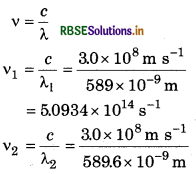
= 5.0881 × 1014 s-1
E = hv
E1 = hv1
E2 = hv2
∆E = E1 - E2 = hv1 - hv2
= h(V1 - V2)
= 6.626 × 10-34 (5.0934 × 1014 – 5.0881 × 1014)
= 6.625 × 10-34 × 0.0053 × 1014
= 0.0346 × 10-20
= 3.46 × 10-22J
Question 2.51.
The work function for caesium atom is 1.9 eV. Calculate (a) the threshold wavelength and (b) the threshold frequency of the Structure of Atom 93 radiation. If the caesium element is irradiated with a wavelength 500 nm, calculate the kinetic energy and the velocity of the ejected photoelectrons.
Answer:
Work function for caesium atom (W) = 1.9 eV = 1.9 × 1.602 × 10-19 J
= 3.0438 × 10-19 J
Thesehold frequency (vo) = \(\frac{W_o}{h}\)
\(=\frac{3.0438 \times 10^{-19} \mathrm{~J}}{6.626 \times 10^{-34} \mathrm{Js}}\)
= 4.59 × 1014 s-1
Thesehold wavelength ( λ 0) = \(\frac{c}{v_o}\)
\(=\frac{3.0 \times 10^8 \mathrm{~m} \mathrm{~s}^{-1}}{4.59 \times 10^{14} \mathrm{~s}^{-1}}\)
= 0.6536 × 10-6 m
= 653.6 × 10-6 m
= 653.6 nm
∵ Wavelength (2) = 500 nm
\(v=\frac{c}{\lambda}=\frac{3.0 \times 10^8 \mathrm{~m} \mathrm{~s}^{-1}}{500 \times 10^{-9} \mathrm{~m}}\)
= 6.0 × 1014 s-1
∴ K.E. of photoelectron = h(v - vo)
= 6.626 × 10 (6.0 × 1034 - 49 × 1014)
= 9.34 × 10-20 J
Now,
K.E = 1/2mv2
Mass of electron (m) = 9.1 × 10-31 kg
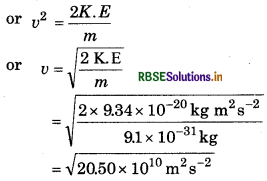
= 4.53 × 105 ms-1
So, velocity of the ejected photoelectrons is 4.53 × 105 ms-1.

Question 2.52.
Following results are observed when sodium metal is irradiated with different wavelengths. Calculate (a) threshold wavelength and, (b) Planck's constant
Answer:
Suppose threshold wave length = 20 nm
Then h(v - v1 ) = 1/2mv2 or \(h c\left[\frac{1}{\lambda}-\frac{1}{\lambda_0}\right]=\frac{1}{2} m v^2\)
Substituting the given reswts of the three experiments,
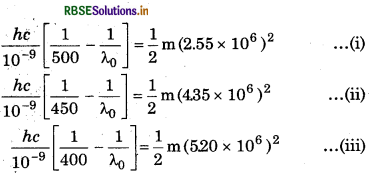
Deviding equation (ii) by equation (i) we get
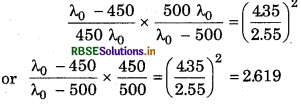
or λ0 - 450 = 2.619λ0 - 1309.5
or 1619λ0 = 859.5
∴ \(\lambda_0=\frac{859.5}{1.619}\) = 531 nm.
Substituting this value in equation (iii) we get
\(\frac{h \times\left(3 \times 10^8\right)}{10^{-9}}\left[\frac{1}{400}-\frac{1}{531}\right]\)
h = 6.66 × 10-34 Js
Question 2.56.
The ejection of the photoelectron from the silver metal in the photoelectric effect experiment can be stopped by applying the voltage of 0.35 V when the radiation 256.7 nm is used. Calculate the work function for silver metal.
Answer:
Voltage applied (V) = 0.35 V
Wavelength of radiation (λ) = 256.7 nm
= 256.7 × 10-9 m
Energy (E) =
\(=\frac{6.626 \times 10^{-34} \mathrm{Js} \times 3.0 \times 10^8 \mathrm{~m} \mathrm{~s}^{-1}}{256.7 \times 10^{-9} \mathrm{~m}}\)
= 7.74 × 10-19 J
\(=\frac{7.74 \times 10^{-19}}{1.602 \times 10^{-19}}\)
= 4.83 eV
Applied voltage gives the kinetic energy (K.E.) to the photoelectron,
K.E. = eVo
= 1.602 × 10-19 × 0.35
= 0.5607 × 10-19 J
\(=\frac{0.5607 \times 10^{-19}}{1.602 \times 10^{-19}}\)
= 0.35 eV
Work function (W) = Energy of incident radiation
Kinetic energy (K.E.)
= 4.83 - 0.35
= 4.48 eV
Question 2.54.
If the photon of the wavelength 150 pm strikes an atom and one of its inner bound electrons is ejected out with a velocity of 1.5 × 107m s1, calculate the energy with
which it is bound to the nucleus.
Answer:
Wavelength of photon (2) = 150pm = 150 × 10-12 m
Velocity of electron (v) = 1.5 × 107 m s-1
Velocity of light radiation (c) = 3.0 × 108 m s-1

= 0.1325 × 10-14
= 1.325 × 1015 J
K.E. of ejected electron =
= 1/2 × 9.1 × 10-31 × (1.5 × 107)2
= 1024 × 10-17 J
= 1.024 × 10-16 J
Work function (W) = hv0
= hv - 1/2 mv2
= E - K.E. of ejected electron
= 1.325 × 10-15 J - 1.024 × 10-16 J
= 13.25 × 10-16 J - 1.024 × 10-16 J
= 12.226 × 10-16 J
\(=\frac{12.226 \times 10^{-16}}{1.602 \times 10^{-19}}\)
= 7.63 × 103 eV
Question 2.55.
Answer:
Emission transitions in the Paschen series and at orbit n = 3 and start from orbit n and can be represented as v = 3.29 × 1015 (Hz). [1/32 - 1/n2].
Calculate the value of n if the transition is observed at 1285 nm. Find the region of the spectrum.
Answer:
v = 3.29 × 1015 (Hz)
λ = 1285 nm = 1285 x 10-9 m
But \(v=\frac{c}{\lambda}\)
So equation (1) becomes
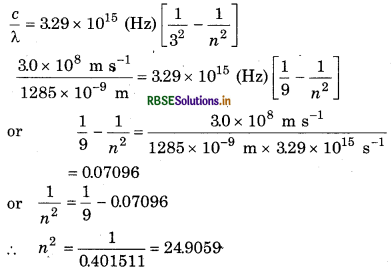
n = 5
Hence, the electron jumps from n = 5 to n = 3. Since, this transition occurs in Paschen series which lie in the infrared region of light.

Question 2.56.
Calculate the wavelength for the emission transition if it starts from the orbit having radius 1.3225 nm and ends at 211.6 pm. Name the series to which this transition belongs and the region of the spectrum. 1322.5 pm
Answer:
r1 = 1.3225 nm = 13225 nm
r2 = 211.6pm
∵ Radius of nth orbit, rn
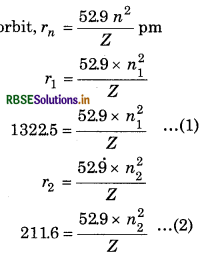
On dividing equation (1) from equation (2),
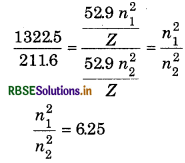
If n1 = 2, n2 = 5, so, the transition takes place from fifth orbit to second orbit and it belongs to Balmer series.
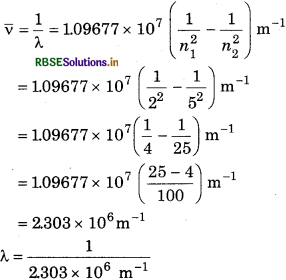
= 0.434216 × 10-6
= 434.216 × 10-9
= 434 nm
So, it belongs to visible region.
Question 2.57.
Dual behaviour of matter proposed by de Broglie led to the discovery of electron microscope often used for the highly magnified images of biological molecules and other type of material. If the velocity of the electron in this microscope is 16× 106 m s-1, calculate de-Broglie wavelength associated with this elecctron.
Answer:
Velocity of electron (v) = 1.6 × 106 m s-1
Mass of electron (m) = 9.1 × 10-31 kg
According to de-Broglie equation,
\(\lambda=\frac{h}{m v}=\frac{6.626 \times 10^{-34} \mathrm{Js}}{9.1 \times 10^{-31} \mathrm{~kg} \times 16 \times 10^6 \mathrm{~m} \mathrm{~s}^{-1}}\)
= 0.455 × 10-9 m
= 455 × 10-12 m
= 455 pm
Question 2.58.
Similar to electron diffraction, neutron diffraction microsope is also used for the determination of the structure of molecules. If the wavelength used here is 800 pm, calculate the characteristic velocity associated with the neutron.
Answer:
Wavelenth (2) = 800 pm = 800 × 10-12 m
Mass of neutron (m) = 1.675 × 10-27
According to de-Broglie equation,
\(\lambda=\frac{h}{m v}=\frac{6.626 \times 10^{-34} \mathrm{Js}}{9.1 \times 10^{-31} \mathrm{~kg} \times 16 \times 10^6 \mathrm{~m} \mathrm{~s}^{-1}}\)
= 0.494 × 103 m s-1
= 4.94 × 102 m s-1
Question 2.59.
If the velocity of the electron in Bohr's first orbit is 2.19 × 106 m s-1, calculate the de-Broglie wavelength associated with it.
Answer:
Velocity of electron (v) = 2.19 × 106 m s
Mass of electron (m) = 9.1 × 10-31 kg
\(\begin{aligned} \lambda & =\frac{h}{m v} \\ & =\frac{6.626 \times 10^{-34} \mathrm{Js}}{9.1 \times 10^{-31} \mathrm{~kg} \times 2.19 \times 10^6 \mathrm{~m} \mathrm{~s}^{-1}} \end{aligned}\)
= 3.32 × 10-10 m
= 332 × 10-12 m
= 332 pm
Question 2.60.
The velocity associated with a proton moving in a potential difference of 1000 V is 4.37 × 105 m s-1. If the hockey ball of mass 0.1kg is moving with this velocity, calculate the wavelength associated with this velocity.
Answer:
Velocity of ball (v) = 437 × 105 m s
Mass of the ball (m) = 0.1 kg
Wavelength \((\lambda)=\frac{h}{m v}\)
\(=\frac{6.626 \times 10^{-34} \mathrm{kgm}^2 \mathrm{~s}^{-1}}{0.1 \mathrm{~kg} \times 4.37 \times 10^5 \mathrm{~m} \mathrm{~s}^{-1}}\)
= 15.16 × 10-27 m
= 1.516 × 10-28 m

Question 2.61.
If the position of the electron is measured within an accuracy of ± 0.002 nm, calculate the uncertainty in the momentum of the electron. Suppose the momentum of the electron is h/4mm × 0.05 nm, is there any problem in defining this value?
Answer:
Uncertainty in position of electron (Ax) = 0.002 nm = 2 × 10-3 nm
= 2 × 10-12 m
According to Heisenberg uncertainty principle,
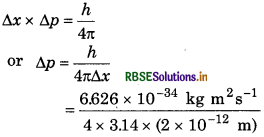
= 2.638 × 10-23 kg m s
Now, Actual momentum = \(\frac{h}{4 \pi \times 0.05 \mathrm{~nm}}\)
\(=\frac{6.626 \times 10^{-34} \mathrm{~kg} \mathrm{~m}^2 \mathrm{~s}^{-1}}{4 \times 3.14 \times 5 \times 10^{-11} \mathrm{~m}}\)
= 1.055 × 10 kg m-1 s
So, there is a problem in defining this value and it can not be defined because actual magnitude of momentum is smaller than the uncertainty in momentum.
Question 2.62.
The quantum numbers of six electrons are given below. Arrange them in order of increasing energies. If any combination(s) has/have the same energy:
tablee
Answer:
tablee
Hence, increasing order of energies of above subshells:
5(3 p) < 2(3d) = 4 (3d) < 6(4p) = 3(4p) < 1(4d)
Question 2.63.
The bromine atom possesses 35 electrons. It contains 6 electrons in 2p orbital, 6 electrons in 3porbital and 5 electrons in 4p orbital. Which of these electrons experiences the lowest effective nuclear charge?
Answer:
No. of electrons in Br atom = 35
No. of electrons in 2p orbital = 6
No. of electrons in 3p orbital = 6
No. of electrons in 4p orbital = 5
35Br = 2, 8, 18, 7
1s2, 2s2 2p6, 3s2 3p6 3d10, 4s2 4p5
Since, effective nuclear charge decreases as the distance of the orbitals increases from the nucleus. Hence, 4p electrons experience the lowest effective nuclear charge.
Question 2.64.
Among the following pairs of orbitals which orbital will experience the larger effective nuclear charge ? (i) 2s and 3s. (ii) 4d and 4f. (iii) 3d and 3p.
Answer:
The effective nuclear charge decreases as the distance of the orbitals increases from the nucleus.
(i) 2s and 3s
∵2s is closer to the nucleus than 3s, so, 2s orbital experiences larger effective nuclear charge then 3s.
(ii) 4d and 4f
∵ 4d is closer to the nucleus than 4f, so, 4d orbital experiences larger effective nuclear charge than 4f.
(iii) 3d and 3p
∵ 3p is closer to the nucleus than 3d, so 3p-orbital experiences larger effective nuclear charge than 3d.
Question 2.65.
The unpaired electrons in Al and Si are present in 3p orbital. Which electrons will experience more effective nuclear charge from the nucleus?
Answer:
Electronic configuration of 13 Al
= 2, 8, 3
= 1s2, 2s2 2p6, 3s2 3p1
Electronic configuration of 14 Si
= 2, 8, 4
= 1s2, 2s2 2p6, 3s2 3p2
Since, Si (+4) has higher nuclear charge than aluminium (+3). So, 3 punpaired electrons of Si will experience more effective nuclear charge than Al.

Question 2.66.
Indicate the number of unpaired electrons in (a) P, (b) Si, (c) Cr, (d) Fe and (e) Kr.
Answer:
(a)
15 P = 2, 8, 5
= 1s2, 2s2 2p6, 3s2 3p3.
No. of unpaired electrons = 3

(b)
14 Si = 2, 8, 4
= 1s2, 2s2 2p6, 3s2 3p2
No. of unpaired electrons = 2

= 1s2, 2s2 2p6, 3s2 3p6 3d5, 4s1
(c) 24 Cr = 2, 8, 13, 1
No. of unpaired electrons = 6

(d)
26 Fe = 2, 8, 14, 2
= 1s2, 2s2 2p6, 3s2 3p6 3d6, 4s2
No. of unpaired electrons = 4

(e)
36 Kr = 2, 8, 18, 8
= 1s2, 2s2 2p6, 3s2 3p6 3d1o, 4s2 4p6
No. of unpaired electrons = 0
Question 2.67.
(a) How many subshells are associated with n = 4?
(b) How many electrons will be present in the subshells having m ̧ value of - 1/2 for n = 4?
Answer:
(a) For n = 4
Values of I will be 0 to (n - 1).
i.e., l = 0 (s-subshell)
1 (p-subshell)
2 (d-subshell)
3 (f-subshell)
So, there are four subshells associated with n = 4.
(b) Number of orbitals in 4th shell = n2
= (4)2 = 16
Maximum number of electrons present in orbital Each orbital has one electron with m = -1/2
Hence, there are 16 electrons with ms = -1/2

- RBSE Class 11 Chemistry Important Questions Chapter 2 Structure of Atom
- RBSE Solutions for Class 11 Chemistry Chapter 14 Environmental Chemistry
- RBSE Solutions for Class 11 Chemistry Chapter 13 Hydrocarbons
- RBSE Solutions for Class 11 Chemistry Chapter 12 Organic Chemistry - Some Basic Principles and Techniques
- RBSE Solutions for Class 11 Chemistry Chapter 11 The p-Block Elements
- RBSE Solutions for Class 11 Chemistry Chapter 10 The s-Block Elements
- RBSE Solutions for Class 11 Chemistry Chapter 9 Hydrogen
- RBSE Solutions for Class 11 Chemistry Chapter 8 Redox Reactions
- RBSE Solutions for Class 11 Chemistry Chapter 7 Equilibrium
- RBSE Solutions for Class 11 Chemistry Chapter 6 Thermodynamics
- RBSE Solutions for Class 11 Chemistry Chapter 5 States of Matter